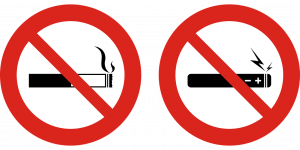Evidence based: e-cigarettes at work
First published in Health and Safety at Work Magazine, July 2016, and edited in 2023.
In 2016 Public Health England, ‘The Royal College of Physicians, and even Cancer Research UK (CRUK) were pushing e-cigarettes as “95% less harmful than cigarettes.” Finding the source of the statistic took me down a time-consuming rabbit hole. What I found appalled me at its lack of scientific basis. It would be like guessing shoe sizes, and then stating that someone estimated to have a size 5 shoe had a 50% smaller foot than someone estimated to have a size 10 shoe. Wrong on so many levels.
I am not alone if having challenged the 95% less harm figure, but zombie statistics have a way of “sticking” and you will still find it in more recent articles.
Should we ban e-cigarettes at work?
Smoking cigarettes, pipes, cigars or herbal cigarettes in indoor workplaces has been banned since 1 July 2007, under the Health Act 2006. E-cigarettes, also known as ENDS (Electronic Nicotine Delivery Systems) do not burn tobacco; instead, they heat and vaporise a liquid containing nicotine and other chemicals, so that the nicotine can be inhaled. Because there is no smoke, the law treats ENDS in relation to use in public places in the same way that it treats nicotine patches, gums, lozenges or nasal sprays. This does not stop individual organisations from banning e-cigarettes in the workplace though, just as employers can ban alcohol, hot drinks or eating as part of a workplace policy.
Outside the workplace, it is illegal for retailers to sell either cigarettes or e-cigarettes to someone under the age of 18. Cigarettes cannot be advertised at all; while e-cigarette advertising is allowed in some circumstances. While smoking in a vehicle carrying someone under 18 is illegal, it is not illegal to vape in the same circumstances. These conflicting rules can leave an employer confused as to what attitude to take.

Divide and confuse
The experts are also divided. In summer 2015, Cancer Research UK opposed a ban on the use of e-cigarettes indoors that had been proposed by the Welsh Assembly, arguing that “E-cigarettes – although not risk free – are almost certainly far safer than smoking tobacco cigarettes.” It continued: “There isn’t enough evidence to justify a ban on the use of e-cigarettes indoors.” Cancer Research has also been clear that it considers e-cigarettes to be a positive move away from smoking, and that banning their use indoors “could create more barriers for smokers trying to quit tobacco”. I can at least report that by 2023, CRUK had a more considered approach to vaping, stating “E-cigarettes are not risk-free. We don’t yet know their long-term effects.”
The Royal College of Physicians (RCP) published a report and position statement in April 2016 arguing that e-cigarettes should be promoted “as widely as possible as a substitute for smoking in the UK”. Public Health England has cited Cancer Research UK and the RCP in its reports, and in July 2016 went further by publishing Use of E-Cigarettes in Public Places and Workplaces, which says employers can endorse the practice if policies adopt five key principles. Take a look at the five principles in the table – 2 and 3 are still short of hard evidence.
On the other side of the argument are the World Health Organisation (WHO) and the British Medical Association (BMA), the professional institute for doctors. The WHO proposes greater restrictions on the use, sale and promotion of e-cigarettes. It claimed in a 2014 report, Electronic nicotine delivery systems, that: “The evidence is sufficient to caution children and adolescents, pregnant women and women of reproductive age about ENDS use, because of the potential for fetal and adolescent nicotine exposure to have long-term consequences for brain development.”
The BMA supports a ban on e-cigarettes in all public places where smoking is already banned, complaining of a lack of peer-reviewed evidence on the safety or effectiveness of e-cigarettes. In a 2012 briefing paper, it states that doctors believe the ban is necessary “to protect others from being exposed to their vapours, and to ensure their use does not undermine smoke-free restrictions or reinforce the normalcy of smoking behaviour”. Some of these concerns are echoed in a 2017 position paper from the BMA, although talk of a ban seems to have disappeared.
Five principles to satisfy to allow e-cigarettes in public places and workplaces
| 1 | Make clear the distinction between vaping and smoking |
| 2 | Ensure policies are informed by the evidence on health risks to bystanders |
| 3 | Identify and manage risks of uptake by children and young people |
| 4 | Support smokers to stop smoking and stay smokefree |
| 5 | Support compliance with smokefree law and policies |
From Public Health England, 2016 “Use of e-cigarettes in public places and workplaces”.
A workable policy for work

If the medical and public health experts disagree, what should the stance of employers be? The BBC and Transport for London banned the use of e-cigarettes on their premises; however, ACAS, the government’s employment conciliation service, suggests that “Employers may want to consider organising a separate vaping areas in or near the workplace”. The House of Commons initially allowed, then banned, and then restricted vaping to designated locations. No wonder employers are unsure.
What employers must not do, however, is ignore the issue. Organisations need a clear policy on whether to allow people to “vape” anywhere, nowhere or in restricted areas, to avoid misunderstandings and legal action. If it’s appropriate to prohibit e-cigarettes in your workplace, this needs to be written into a workplace policy, and understood by all staff.
This was demonstrated in the Insley v Accent Catering employment tribunal case in February 2015, when a school catering assistant who had been caught vaping was suspended and asked to attend a disciplinary hearing. She resigned, and then took a constructive dismissal claim to employment tribunal. Although the tribunal decided that the suspension was reasonable and she had not been unfairly dismissed, it indicated that a decision to dismiss her for using e-cigarettes on the premises could have been judged unfair, as there was nothing in the employer’s policy that prohibited their use.
This is where I went down my rabbit hole of research…
While I couldn’t disagree with the overall finding that vaping was (probably) less harmful than smoking, where did the “95% less harmful” figure come from?
An evidence update on e-cigarettes from the UK Centre for Tobacco & Alcohol Studies, commissioned by PHE (McNeill et al, 2015) concluded with an estimate that e-cigarettes are 95% less harmful than cigarettes.
McNeill gives a reference to a paper in European Addiction Research in 2014 (Nutt et al) where the only figure given in relation to e-cigarettes is that using “multi-criteria decision analysis” (MCDA) e-cigarettes and other Electronic Nicotine Delivery Systems (ENDS) were rated to have a harm score of 4, compared with a score for the harm of cigarettes of 99.6. Note the use of the word “rated” – the harm in this study was an estimate by experts of the harm of a product in a number of categories – including environmental damage, crime, dependence, economic cost, as well as morbidity and mortality. Nutt et al explained the limitations of the figure but by 2015 the expert estimate has become a scientific “fact”, quoted and requoted by ASH, PHE and other supporters of e-cigarettes as the actual reduction in harm. It is like guessing my shoe size to be a 5, and then stating that your size 10 must be twice the size. Your estimate was wrong, and even if it were right, that’s not how ranking numbers work.

Like guesses about shoe sizes, you can't apply a % difference to guesses about harm scores
Although the size of the risk reduction appears to be unsubstantiated, and perhaps is impossible to substantiate given the variation in product ingredients and concentrations, usage patterns and smoking / vaping habits, even WHO and the BMA admit that they are less harmful to the user that cigarettes. The BMA advice to doctors is to advise patients to use NHS stop smoking services, but that “if asked .. should inform that they are likely to be a lower risk option than continuing to smoke.”
Passive vaping
For the bystander, if the comparison is between inhaling second-hand tobacco smoke or second-hand vapour, there is general agreement that vapour is less harmful. For example, in Nicotine and Tobacco Research (2013) Czogala et al conclude that second-hand smoke from cigarettes contained ten times more nicotine than second-hand vapour. McNeill et al [above] cite one study where cigarette exhalations were measured to contain eight times more nicotine than e-cigarette exhalations, concluding that the e-cigarettes “release negligible levels of nicotine into ambient air with no identified health risks to bystanders”.
On the other hand, the WHO has some concerns, finding evidence that exhaled e-cigarette vapour “increases the background air level of some toxicants, nicotine and particles … The fact that ENDS-exhaled aerosol contains on average lower levels of toxicants than the emissions from combusted tobacco does not mean that these levels are acceptable to involuntarily exposed bystanders.”
A report from the Center for Tobacco Control Research and Education in the USA, commissioned by the WHO (Grana et al, 2014), agrees that e-cigarettes deliver “some toxins” which could be inhaled by bystanders, and could be especially harmful in the long term to children. With such a range of opinions, the verdict is out on whether toxins from e-cigarettes pose significant harm.
For workplaces now enjoying a legislation-backed smoke-free environment, the choice is not smoking versus vaping, but zero tolerance versus e-cigarettes. Any tobacco smoke on the premises will be confined to smoking areas outside the building. Is there any case for allowing e-cigarette vapour, even if you perceive the risks to be low, into your workplace?
Fire risk
A further concern raised by many employers and landlords is the fire risk associated with e-cigarette chargers. Even if you ban the use of e-cigarettes in your building, without a policy that clearly states the rules, employees might plug in their e-cigarette chargers at work, ready for the next break.
How much additional risk would this present? In 2014, the BBC obtained information from 43 UK fire services, which showed that the number of fires identified as having been started by e-cigarettes rose from eight in 2012 to over 60 in 2014. However, Public Health England and ASH argue that the risk of an electrical fire is no worse than for any other household appliance.
Although the number of fires is small compared with fires for electrical appliance failures generally, it makes sense for a workplace to communicate clear rules to staff about what is – and isn’t – allowed for e-cigarette chargers, and any other electric devices brought in from home. Advice on the issue from the Chief Fire Officers Association provides a useful starting point – see the table for a summary.
Advice from NFCC on vaping
| 1 | Buy products from reputable dealers |
| 2 | Only use chargers designed for use with the specific device. Some chargers may overcharge the product, leading to an increased risk of fire |
| 3 | Never leave a vaping device charging unattended, and never leave them charging overnight – especially next to your bed |
| 4 | Never use a vaping device close to medical oxygen, flammable emollient creams or airflow mattresses |
| 5 | Do not buy counterfeit goods as batteries and/or chargers are unlikely to have overcurrent protection and could lead to batteries exploding |
| 6 | Never modify or adapt personal vaporisers and their associated kit |
| 7 | Never use damaged equipment or batteries Fire is not the only risk posed by vaping products and the liquid they contain can be highly toxic |
From www.nationalfirechiefs.org.uk/Vaping-tobacco-position-statement, September 2017
Do they help people give up?
Employers might choose to provide dedicated vaping areas in the belief that this will help staff to give up smoking. But the experts are again divided on whether e-cigarettes are an effective way to quit.
A randomised control trial in The Lancet in 2013 (Bullen et al) reported that people trying to quit were more successful at six months when provided with e-cigarettes than with nicotine patches or nicotine-free placebo e-cigarettes. However, with just 7.3% of e-cigarette users giving up, compared to 5.8% of nicotine patch users and 4.1% of the placebo group, the results were hardly a ringing endorsement. When I reviewed this article in 2023, I found a Cochrane review from 2022 had similar results: while behavioural support had a success rate of just 4%, and nicotine-replacement therapy 6%, non-nicotine e-cigarettes pushed the success rate up to just 7%. Nicotine e-cigarettes were more successful in getting people to stop smoking – up to 14% of people were able to give up cigarettes. However, in most cases ex-smokers became dependent on vaping, rather than beoming nicotine free.
In reality, e-cigarettes will help some people, while for others it will be an excuse not to give up, or a way of keeping their nicotine levels up in between opportunities to smoke real cigarettes.
Another dilemma for the employer is whether e-cigarette tolerance could encourage people who don’t smoke to try vaping. American research (Bunnell et al 2015) published in Nicotine and Tobacco Research found that high school students who had used e-cigarettes were nearly twice as likely to have intentions to smoke real cigarettes than those who had never vaped. The study was unable to show whether this is because people who intend to take up smoking are more likely to also try e-cigarettes, or if the use of e-cigarettes encouraged the students to think of smoking.
In a survey of British youngsters aged 11 to 16 (Ford et al, 2016) published in the International Journal of Public Health, respondents perceived fruit and candy-floss-flavoured e-cigarettes to be less harmful than tobacco or coffee-flavoured versions. The 2022 Annual National Youth Tobacco Survey in the USA showed that of the 2.5 million 11- to 18-year-olds who use e-cigarettes, nearly 85% used flavoured e-cigarettes, with fruit, candy and dessert flavours being the most popular.
Figures from the UK government’s Health and Social Care Information Centre (HSCIC) in 2016 suggested that 35% of 15-year-olds and 5% of 11-year-olds admitted to trying e-cigarettes. More recent data from NHS Digital (the replacement for HSCIC) suggests that while use of drugs and conventional cigarettes is reducing in this age group, the number of 15-year-olds who have ever used e-cigarettes has gone up to 39%, with 18%.using them at the time of the study survey.
Conclusion
In deciding how to manage e-cigarettes in the workplace, employers need to weigh up the argument presented by Chapman in the British Medical Journal (2013) that “e-cigarettes might renormalise smoking, promote experimentation among young people who otherwise may not have tried smoking … and thereby deter some smokers from stopping” with the Cancer Research UK view that e-cigarettes are “almost certainly far safer” than traditional cigarettes.
If your organisation decides to ban e-cigarettes, be careful how you word the policy. Some companies have unintentionally banned the use of nicotine patches or gum by careless wording.
If you decide on a separate area for vaping, this can be fully or substantially enclosed – unlike a smoking area. However, adequate ventilation and heat detection would be sensible precautions. If you employ younger workers, consider whether they need extra protection.
This is also an opportunity to revisit your electrical safety policy to make sure the rules for staff bringing in any electrical items, including e-cigarette chargers, are clear and enforced.
What the evidence demonstrates, including the Insley v Accent Catering employment tribunal case, is that the problem of managing vaping in the workplace should not be ignored.

